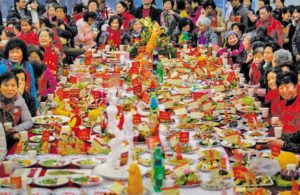Some point in late 2019: The coronavirus jumps from some animal species to a human being. The best guess at this point is that it happened at a Chinese “wet market.”
December 6: According to a study in The Lancet, the symptom onset date of the first patient identified was Dec 1, 2019.
December 21: Wuhan doctors begin to notice a “cluster of pneumonia cases with an unknown cause.”
December 25: Chinese medical staff in two hospitals in Wuhan are suspected of contracting viral pneumonia and are quarantined. This is additional strong evidence of human-to-human transmission.
Sometime in “Late December”: Wuhan hospitals notice “an exponential increase” in the number of cases that cannot be linked back to the Huanan Seafood Wholesale Market, according to the New England Journal of Medicine.
December 30: Dr. Li Wenliang sent a message to a group of other doctors warning them about a possible outbreak of an illness that resembled severe acute respiratory syndrome (SARS), urging them to take protective measures against infection.
December 31: The Wuhan Municipal Health Commission declares, “The investigation so far has not found any obvious human-to-human transmission and no medical staff infection.” This is the opposite of the belief of the doctors working on patients in Wuhan, and two doctors were already suspected of contracting the virus.
Three weeks after doctors first started noticing the cases, China contacts the World Health Organization.
January 1: The Wuhan Public Security Bureau issued summons to Dr. Li Wenliang, accusing him of “spreading rumors.” Two days later, at a police station, Dr. Li signed a statement acknowledging his “misdemeanor” and promising not to commit further “unlawful acts.” Seven other people are arrested on similar charges and their fate is unknown.
Also that day, “after several batches of genome sequence results had been returned to hospitals and submitted to health authorities, an employee of one genomics company received a phone call from an official at the Hubei Provincial Health Commission, ordering the company to stop testing samples from Wuhan related to the new disease and destroy all existing samples.”
According to a New York Times study of cellphone data from China, 175,000 people leave Wuhan that day. According to global travel data research firm OAG, 21 countries have direct flights to Wuhan. In the first quarter of 2019 for comparison, 13,267 air passengers traveled from Wuhan, China, to destinations in the United States, or about 4,422 per month. The U.S. government would not bar foreign nationals who had traveled to China from entering the country for another month.
January 2: One study of patients in Wuhan can only connect 27 of 41 infected patients to exposure to the Huanan seafood market – indicating human-to-human transmission away from the market.
Also on this day, the Wuhan Institute of Virology completed mapped the genome of the virus. The Chinese government would not announce that breakthrough for another week.
January 3: The Chinese government continued efforts to suppress all information about the virus: “China’s National Health Commission, the nation’s top health authority, ordered institutions not to publish any information related to the unknown disease, and ordered labs to transfer any samples they had to designated testing institutions, or to destroy them.”
Roughly one month after the first cases in Wuhan, the United States government is notified. Robert Redfield, the director of the Centers for Disease Control and Prevention, gets initial reports about a new coronavirus from Chinese colleagues.
Also on this day, the Wuhan Municipal Health Commission released another statement, repeating, “As of now, preliminary investigations have shown no clear evidence of human-to-human transmission and no medical staff infections.”
January 4: The head of the University of Hong Kong’s Centre for Infection, Ho Pak-leung, warned that “the city should implement the strictest possible monitoring system for a mystery new viral pneumonia that has infected dozens of people on the mainland, as it is highly possible that the illness is spreading from human to human.”
January 6: The New York Times publishes its first report about the virus, declaring that “59 people in the central city of Wuhan have been sickened by a pneumonia-like illness.”
Also that day, the CDC “issued a level 1 travel watch – the lowest of its three levels – for China’s outbreak.
Also that day, the CDC offered to send a team to China to assist with the investigation. The Chinese government declined, but a WHO team that included two Americans would visit February 16.
January 8: Chinese medical authorities claim to have identified the virus.
January 10: After unknowingly treating a patient with the Wuhan coronavirus, Dr. Li Wenliang started coughing and developed a fever. He was hospitalized on January 12. In the following days, Li’s condition deteriorated so badly that he was admitted to the intensive care unit and given oxygen support.
January 11: The Wuhan City Health Commission issues an update declaring, “All 739 close contacts, including 419 medical staff, have undergone medical observation and no related cases have been found . . . No new cases have been detected since January 3, 2020. At present, no medical staff infections have been found, and no clear evidence of human-to-human transmission has been found.”
Also on this day, political leaders in Hubei province, which includes Wuhan, began their regional meeting. The coronavirus was not mentioned over four days of meetings.
January 13: Authorities in Thailand detected the virus in a 61-year-old Chinese woman who was visiting from Wuhan, the first case outside of China.
January 14: Wuhan city health authorities release another statement declaring, “Among the close contacts, no related cases were found.” Wuhan doctors have known this was false since early December, from the first victim and his wife, who did not visit the market.
January 15: Japan reported its first case of coronavirus.
The Wuhan Municipal Health Commission begins to change its statements, now declaring, “Existing survey results show that clear human-to-human evidence has not been found, and the possibility of limited human-to-human transmission cannot be ruled out, but the risk of continued human-to-human transmission is low.”
January 17: The CDC and the Department of Homeland Security’s Customs and Border Protection announce that travelers from Wuhan to the United States will undergo entry screening for symptoms associated with 2019-nCoV at three San Francisco, New York (JFK), and Los Angeles airports that receive most of the travelers from Wuhan, China.
Despite the fact that Wuhan doctors know the virus is contagious, city authorities allow 40,000 families to gather and share home-cooked food in a Lunar New Year banquet.
January 19: The Chinese National Health Commission declares the virus “still preventable and controllable.”
January 20: The Wuhan Municipal Health Commission declares for the last time in its daily bulletin, “no related cases were found among the close contacts.”
Head of China’s national health commission team investigating the outbreak, confirmed that two cases of infection in China’s Guangdong province had been caused by human-to-human transmission and medical staff had been infected.
The Wuhan Evening News newspaper, the largest newspaper in the city, mentions the virus on the front page for the first time since January 5.
January 21: The CDC announced the first U.S. case of a the coronavirus in a Snohomish County, Wash., resident who returning from China six days earlier.
By this point, millions of people have left Wuhan, carrying the virus all around China and into other countries.
January 23: Chinese authorities announce their first steps for a quarantine of Wuhan. By this point, millions have already visited the city and left it during the Lunar New Year celebrations. Singapore and Vietnam report their first cases, and by now an unknown but significant number of Chinese citizens have traveled abroad as asymptomatic, oblivious carriers.
January 24: Vietnam reports person-to-person transmission, and Japan, South Korea, and the U.S report their second cases.
February 1: Dr. Li Wenliang tested positive for coronavirus. He died from it six days later.
February 4: Mayor of Florence, Italy, Dario Nardella urged residents to hug Chinese people to encourage them in the fight against the novel coronavirus. Meanwhile, a member of Associazione Unione Giovani Italo Cinesi, a Chinese society in Italy aimed at promoting friendship between people in the two countries, called for respect for novel coronavirus patients during a street demonstration. “I’m not a virus. I’m a human. Eradicate the prejudice.”


February 11: WHO proposed an official name of the virus: COVID-19, an acronym for Coronavirus disease 2019.
February 12: UN activates WHO-led Crises Management Team (CMT) bringing together WHO, OCHA, IMO, UNICEF, ICAO, WFP, FAO, the World Bank and several UN Secretariat departments.
February 13: More than 14,000 new cases were reported in Hubei Province.
February 14: France announces the first coronavirus death in Europe.
February 17: Chinese officials drafted legislation to curb the practice of eating wildlife as it was considered the probable source of the highly contagious disease.
February 19: Hundreds of people left the Diamond Princess cruise ship which was quarantined. People who were tested negative for the virus were offloaded.
February 23: Europe faced its first major outbreak due to the increase in a number of cases in Italy.
February 24: Iran emerged the second focus point of the virus after China.
March 7: Positive COVID-19 cases crossed the 100,000 mark. 100 countries were infected by this time.
March 11: WHO declared COVID-19 as a pandemic. Trump blocks visitors from Europe.
March 12: First death was reported in India due to COVID-19.
March 13: President Trump declared a national emergency in the US. Europe becomes the epicentre of the global pandemic.
March 14: India declared COVID-19 a notified disaster.
March 17: EU bars travellers outside the bloc for a period of 30 days. France imposed nationwide lockdown due to COVID-19.
March 19: Italy overtakes China death tolls.
March 22: India observed Janta Curfew for a day.
March 24: Tokyo Olympics postponed for a year until 2021. Prime Minister Modi announced 21-day lockdown in India.
April 6: Death toll in India crossed the hundred mark.

















